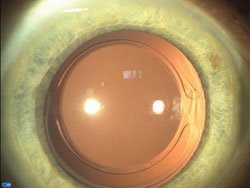New accommodating IOL offers high rate of spectacle independence
Ciliary muscle contraction creates an accommodative effect by vaulting the lens and causing vitreous to push it forward.
 José Manuel Vargas |
A new accommodating IOL uses the eye’s natural focusing mechanics to provide a full range of distance, intermediate and near vision, according to a researcher.
“In my opinion, to restore accommodation, the Tek-Clear accommodating IOL holds the answer of providing good distance, intermediate and near acuity, and has the advantage of causing fewer optical aberrations than multifocal IOLs,” José Manuel Vargas, MD, said in an interview with Ocular Surgery News following the product launch at the World Ophthalmology Congress in Berlin.
Dr. Vargas has seen a 90% spectacle independence rate among select patients implanted with the Tek-Clear accommodating IOL (Tekia) in the last 4 years in his practice.
“My patients have very high levels of satisfaction doing their regular activities like reading, working on the computer, driving and outdoor activities free of glasses,” Dr. Vargas said.
Post-market studies of the Tek-Clear are ongoing in South America and Europe, he said.
Dr. Vargas was involved in initial lens design development, haptic sizing and other physical features and surgical techniques for implantation of the new lens.
Bending beam design
The Tek-Clear IOL features a 360° square-edge haptic and a 5.5-mm optic and is made of 26% hydrophilic acrylic material. The lens is designed for implantation in the capsular bag.
|
Image: Vargas JM |
The lens haptic-optic design uses a bending beam, or vaulting, approach that optimizes IOL movement anteriorly and posteriorly as the ciliary muscle contracts and relaxes during the accommodative process, reducing tension on the zonules, according to company literature.
“This reduced tension allows the capsule to contract, causing a decrease in the equatorial diameter,” Dr. Vargas said. “This process forces the optic to shift forward using a bending beam approach. At the same time, the contracting muscle utilizes the same contracting pressure to the eye to create a hydraulic pressure that causes the vitreous to push the lens forward. The bending beam/hydraulic optic shift principle is best utilized because the round haptic portion of the IOL better fills the capsular bag and provides a full circle contact with the round ciliary muscle.”
As measured by Visante optical coherence tomography (Carl Zeiss Meditec), the lens vaults an average of 880 µm inside the eye.
The lens power ranges from +17 D to +30 D in 0.5 D steps. The 10-mm to 11-mm overall diameter of the lens allows customization in 0.2-mm increments.
“I have an ongoing clinical trial where I customize the size of the IOL according to the patient’s capsular bag diameter,” Dr. Vargas said. “We calculate the capsular bag diameter using a regression formula by [Mana] Tehrani. Once we have the [capsular bag diameter], you can decide the size of the [accommodating] IOL to be implanted and optimize the accommodative effect.”
In-the-bag insertion
The lens is foldable and may be injected through a 2.2-mm to 3-mm incision.
Optimal incision size is 2.2 mm to 2.8 mm. Proper sizing of the incision for implantation depends on the size of the injection cartridge to be used. Dr. Vargas recommended implanting the lens using a 2.2-mm cartridge tip through a 2.4-mm to 2.8-mm clear corneal incision.
“This will allow full insertion of the cartridge into the capsular bag,” Dr. Vargas said.
He recommended using the injector set by Medicel.
Dr. Vargas recommends implantation with a well-centered and circular capsulorrhexis of at least 6 mm in diameter. The lens may be injected progressively inside the capsular bag assisted by a spatula to control in-the-bag lens insertion.
The lens should be positioned with the beam vertically oriented to maximize forward movement, according to company literature.
Indications and patient selection
Meticulous patient selection and precise IOL power calculation will determine the success of the new lens, Dr. Vargas said.
Ideal candidates for the lens are active adults in their 50s to mid-60s who experience diminishing vision because of progressive cataract development. Patients should be motivated but able to temper their expectations regarding visual outcomes, potential complications and side effects.
Lens constants for the IOLMaster (Carl Zeiss Meditec) are offered in the product brochure.
Dr. Vargas suggested selecting patients with preoperative astigmatism less than 1 D. Surgical correction is an option for patients with residual astigmatism, he said.
“If we have a postop residual astigmatism higher than 1 D or any refractive error, LASIK or [limbal relaxing incisions] are good alternatives to correct the problem,” Dr. Vargas said.
The IOL has not been studied against other accommodating IOLs, Dr. Vargas said. The company literature noted areas in which data on the new lens are lacking. For example, the safety and effectiveness of the lens have not been evaluated in patients younger than 40 years. Also, the effect of vitrectomy on accommodation is unknown. Long-term stability of the lens in the human eye has not been validated; surgeons should monitor implanted patients regularly to watch for complications. – by Matt Hasson

- José Manuel Vargas, MD, can be reached at the Ophthalmology Center of Valencia, Av. Bolívar Norte, Torre Venezuela, Piso 2, Valencia, Venezuela; 58-241-824-6989; fax: 58-241-824-8834; e-mail: aim@mail.vu or corneavargas@me.com.

